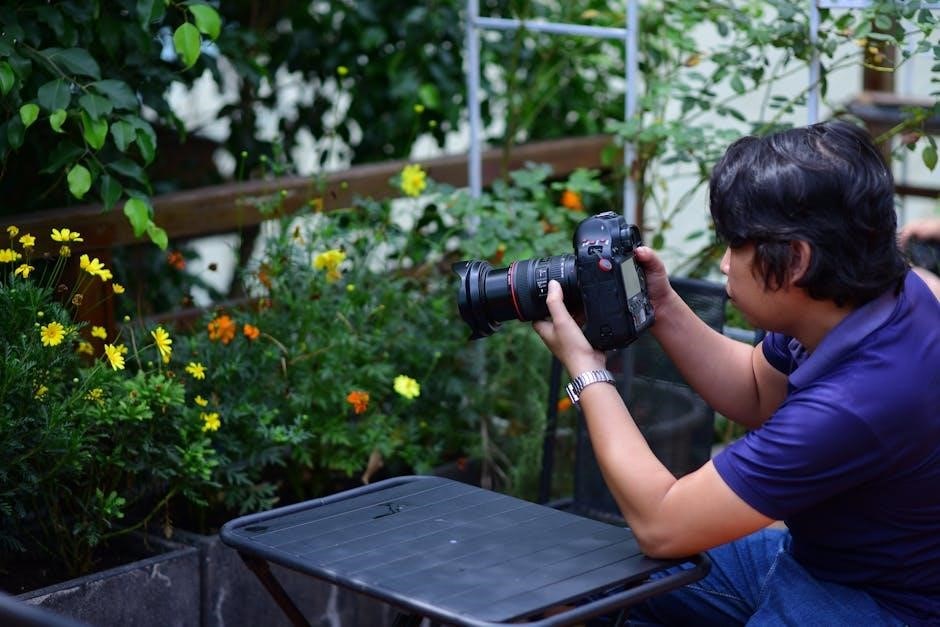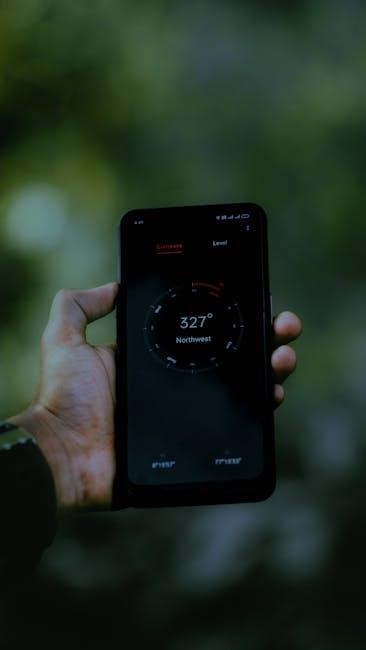The Nikon D50 is a compact, user-friendly SLR digital camera designed for both beginners and photography enthusiasts. It features a 6.1-megapixel sensor, offering excellent image quality and versatility; With its intuitive controls and durable build, the D50 is an ideal choice for capturing memorable moments. Its compatibility with Nikon lenses and accessories, along with SD card support, makes it a practical tool for creative photography.
Key Features of the Nikon D50
The Nikon D50 boasts a 6.1-megapixel CCD sensor, delivering crisp and vibrant images. It features an 5-area autofocus system for precise subject tracking and a built-in flash with Nikon’s Creative Lighting System compatibility. The camera offers various shooting modes, including Auto, Program, Aperture Priority, Shutter Priority, and Manual, catering to both novices and advanced users. With a continuous shooting speed of up to 2.5 frames per second, it’s ideal for capturing dynamic moments. The D50 supports ISO sensitivities from 200 to 1600, ensuring versatility in different lighting conditions. Its 2-inch color LCD provides clear image playback and menu navigation. The camera accepts SD memory cards up to 2GB and offers a battery life of up to 2,000 shots per charge. Lightweight and ergonomic, the D50 is compatible with Nikon’s extensive range of lenses and accessories, making it a versatile choice for photographers of all levels.
Target Audience for the Nikon D50
The Nikon D50 is primarily designed for hobbyists and photography enthusiasts seeking a balance between simplicity and creative control. It is ideal for beginners transitioning from point-and-shoot cameras to DSLRs, offering an intuitive interface and user-friendly features. The camera also appeals to photography students and casual shooters who want to explore advanced techniques without the complexity of professional-grade models. Its lightweight design and affordability make it accessible to a wide range of users, including those on a budget. Additionally, the D50 is a great choice for travelers and event photographers who need a reliable, compact camera for capturing high-quality images. Its compatibility with Nikon lenses and accessories further enhances its appeal for those looking to expand their photography capabilities over time.
Quick Start Guide for Beginners
To get started with your Nikon D50, begin by charging the EN-EL3 battery and inserting it along with an SD memory card. Attach the supplied AF-S DX NIKKOR 18-55mm lens or another compatible lens. Power on the camera using the top dial, set to the green “Auto” mode for point-and-shoot simplicity. Use the viewfinder or LCD screen to frame your shot, press the shutter button halfway to focus, and fully depress it to capture the image. Review your photos on the LCD using the playback button. For basic settings, use the menu system to adjust image quality, white balance, and ISO. Experiment with scene modes like Portrait or Landscape for specific shooting scenarios. Refer to the user manual for detailed instructions on customizing settings and exploring advanced features as you gain confidence in your photography skills.

Camera Components and Accessories
The Nikon D50 includes the EN-EL3 battery, SD memory cards, and an AF-S DX NIKKOR 18-55mm lens. Accessories like the MB-D100 battery grip and Nikon Creative Lighting System enhance functionality and creative control.
Overview of the Camera Body and Build
The Nikon D50 features a durable and lightweight polycarbonate body with a rubberized grip for comfortable handling. Weighing approximately 540 grams, it is compact yet robust, making it ideal for everyday use. The camera’s ergonomic design includes intuitive controls and a well-balanced layout, ensuring easy access to key functions. The body is built to withstand regular use, with a solid construction that feels professional-grade. The D50 also includes a tripod socket for stable mounting and compatibility with a wide range of Nikon lenses. Its compact dimensions (133 x 102 x 76mm) make it portable while maintaining a sturdy feel. The camera’s build quality ensures reliability, catering to both casual shooters and serious enthusiasts. With its reliable construction, the D50 remains a popular choice for photographers seeking a balance of performance and portability.
External Controls and Their Functions
The Nikon D50 features an intuitive layout of external controls designed for easy operation. The Mode Dial on top allows quick selection of shooting modes, including Auto, Program, Aperture Priority, Shutter Priority, and Manual. Adjacent to it, the ISO button enables rapid adjustment of sensitivity settings. On the front, the lens release button and focus mode selector (AF/M) provide quick access to lens changes and focus settings. The rear houses the multi-selector for navigating menus and selecting autofocus points, along with buttons for playback, delete, and help. The top also includes a shutter release button and exposure compensation button for fine-tuning settings. These controls are strategically placed to enhance usability, making it easy to adjust settings without taking your eye from the viewfinder. This ergonomic design ensures a smooth and efficient shooting experience for photographers of all skill levels.
Viewfinder and LCD Display
The Nikon D50 features a high-quality pentamirror viewfinder, providing a clear and accurate preview of your scene. It offers approximately 95% frame coverage and a diopter adjustment for sharp focusing, ensuring precise composition. The 2-inch TFT LCD display on the rear allows for easy playback, menu navigation, and image review. With 132,000 pixels, the LCD delivers decent clarity for reviewing photos and accessing camera settings. The display also supports brightness adjustment, making it usable in various lighting conditions. Together, the viewfinder and LCD provide a reliable and user-friendly interface for photographers to frame, review, and adjust their shots effectively. These features ensure that capturing and reviewing images is both intuitive and efficient, catering to photographers of all levels.
Shooting Modes Explained
The Nikon D50 offers various shooting modes, including Auto, Program, Aperture Priority, Shutter Priority, and Manual, each tailored for different photography needs and skill levels.
Auto Mode for Point-and-Shoot Photography

The Auto Mode on the Nikon D50 is designed for effortless point-and-shoot photography, making it perfect for beginners. In this mode, the camera automatically adjusts settings like aperture, shutter speed, and ISO to ensure optimal results in various lighting conditions. The D50’s advanced metering system and autofocus work seamlessly to deliver sharp, well-exposed images with minimal user input. This mode is ideal for casual shooting, capturing family moments, or when you want to focus solely on composition without worrying about technical settings. The Auto Mode also utilizes the camera’s built-in flash when necessary, ensuring balanced lighting even in low-light situations. This feature-rich yet straightforward mode helps users achieve professional-quality photos with ease.
Program Mode (P)
Program Mode (P) on the Nikon D50 offers a balance between automation and creative control, making it ideal for photographers who want to step beyond Auto Mode. In this mode, the camera automatically selects both aperture and shutter speed to ensure a properly exposed image. However, users can still adjust settings like ISO, white balance, and AF-area mode to fine-tune their results. This mode is perfect for everyday photography, as it adapts well to various lighting conditions while allowing for some customization. The D50’s Program Mode also supports the use of the zoom ring on Nikon lenses, enabling precise framing and composition. Additionally, exposure compensation can be applied to adjust brightness, giving users more control over the final image without the complexity of manual modes. This mode is a great intermediate step for photographers transitioning from Auto to more advanced shooting modes.
Aperture Priority Mode (A)

Aperture Priority Mode (A) on the Nikon D50 allows you to set the aperture manually, while the camera automatically adjusts the shutter speed for optimal exposure. This mode is ideal for controlling depth of field—perfect for portraits with a blurred background or landscapes with maximum sharpness. A lower f-stop (like f/2.8) creates a shallow depth of field, while a higher f-stop (like f/16) keeps more of the image in focus. Adjust the aperture using the command dial, and the camera will compensate with shutter speed. Be mindful of lighting changes and adjust ISO if needed to maintain desired exposure. Experiment with different apertures to achieve your creative vision, ensuring you understand how these settings interact. Practice with various subjects to master this mode and enhance your photography skills.
Shutter Priority Mode (S) and Manual Mode (M)
Shutter Priority Mode (S) allows you to set the shutter speed manually, with the camera adjusting the aperture for proper exposure. This mode is perfect for capturing motion, such as freezing fast-moving subjects or creating artistic motion blur. Manual Mode (M) gives full control over both aperture and shutter speed, enabling precise adjustments for unique lighting conditions. In Manual Mode, you can fine-tune settings to achieve the desired artistic effect, making it ideal for experienced photographers. To use these modes, select “S” or “M” on the mode dial and adjust settings using the command dials. Use the exposure compensation button if needed to refine results. These modes offer advanced control for photographers seeking creative freedom and precision in their work. Experiment with different settings to master dynamic compositions and lighting scenarios. Always review your images to ensure optimal results and adjust settings accordingly for the best outcomes.
Scene Modes for Specific Shooting Situations
The Nikon D50 offers various Scene Modes tailored for specific shooting scenarios, ensuring optimal results with minimal adjustments. These modes include Portrait, Landscape, Sports, Night Portrait, and more. Portrait mode softens backgrounds to emphasize subjects, while Landscape mode enhances depth and clarity for scenic shots. Sports mode freezes fast-moving subjects, and Night Portrait mode balances flash with ambient light for low-light portraits. Each mode automatically adjusts settings like aperture and shutter speed to suit the scene. Access these modes via the mode dial, and let the camera handle the technical details. Scene Modes are perfect for capturing life’s moments effortlessly, providing a balance between simplicity and creativity. They allow users to focus on composition and timing while the camera manages exposure and focus, making photography more enjoyable and accessible for all skill levels. These modes are a great way to explore photography without manual adjustments.

Menu Functions and Customization
The Nikon D50 offers a user-friendly menu system, allowing customization of settings to suit individual preferences. Navigate through Playback, Shooting, Setup, and Custom Settings menus for personalized control over your photography experience.
Navigating the Playback Menu
The Playback Menu on the Nikon D50 allows users to review, manage, and enhance their photos. Key features include image review, deletion options, and slideshow creation. Users can also zoom in on images to check details and protect specific photos from accidental deletion. Customization options enable sorting images into folders and creating print sets. The menu provides display options like histograms and shooting data for better understanding of image parameters. Additionally, users can rotate images and adjust playback folder settings for organized browsing. The Playback Menu is intuitive, making it easy to manage and enjoy your captured moments. Regular firmware updates ensure optimal functionality and compatibility with new features. This section is essential for mastering post-shooting operations and enhancing your photography workflow.
Understanding the Shooting Menu Options
The Shooting Menu on the Nikon D50 provides essential controls for customizing image capture settings. Key options include image quality adjustments (Fine, Normal, Basic) and white balance settings to match lighting conditions. Users can select from various autofocus modes, such as Single AF and Continuous AF, for precise subject tracking. ISO sensitivity can be adjusted to optimize low-light performance, while noise reduction settings help minimize grain in high-sensitivity images. Additional options include metering modes (Matrix, Center-Weighted, Spot) for accurate exposure control and AE lock for freezing exposure settings. The menu also allows for bracketing shots to capture a range of exposures. These features enable photographers to tailor their shooting preferences for diverse scenarios, ensuring high-quality results. Regular firmware updates may expand or refine these options, enhancing the camera’s functionality and user experience. Mastering the Shooting Menu is crucial for unlocking the D50’s full potential.
Custom Settings for Personalized Shooting
The Nikon D50 offers customizable settings to tailor the camera to individual preferences, enhancing shooting efficiency. Users can assign specific functions to buttons, such as the AE-L/AF-L button, for quick access during shooting. Autofocus modes can be fine-tuned for faster or more precise focusing. Additionally, the camera allows customization of the command dial’s behavior, enabling photographers to adjust aperture or shutter speed with ease. These settings can be saved for quick recall, streamlining the workflow. The ability to personalize controls ensures a more intuitive and enjoyable shooting experience, catering to both casual and advanced photographers. By leveraging these customization options, users can optimize the D50’s performance to suit their unique needs and photography style.
Setup Menu for Camera Configuration
The Setup Menu on the Nikon D50 is your go-to for configuring the camera’s basic operational settings. Here, you can set the time zone, date, and language, ensuring all camera functions align with your preferences. Additionally, the Setup Menu allows you to manage folder creation, file naming, and card formatting, streamlining how your images are stored. You can also customize display settings, such as adjusting the LCD brightness and toggling language options. Firmware updates can be initiated through this menu, ensuring your camera stays up-to-date with the latest features and improvements. By organizing these configurations, the Setup Menu helps you tailor the D50’s functionality to your needs, ensuring smooth and efficient operation without affecting image capture settings directly.

Advanced Shooting Techniques
Explore creative photography by mastering advanced techniques like bracketing, panning, and long exposures. These methods enhance your control over lighting and composition for stunning results.
Mastering Autofocus for Sharp Images
Mastering autofocus on the Nikon D50 ensures sharp, clear images. The camera features an advanced 5-area autofocus system, allowing precise subject tracking. Use AF-C for moving subjects and AF-S for stationary ones. Experiment with focus modes to optimize results. For portraits, select the center focus point to lock onto eyes. In dynamic situations, enable continuous autofocus for seamless tracking. Utilize the shutter release half-press to lock focus and recompose shots. Familiarize yourself with autofocus customization in the menu for tailored performance. Regular firmware updates also enhance autofocus accuracy. By understanding and adjusting these settings, you can achieve professional-grade sharpness in every frame. Practice different techniques to refine your skills and make the most of the D50’s autofocus capabilities.
Using Metering Modes Effectively
The Nikon D50 features three metering modes to help you achieve accurate exposures. Matrix Metering is the default mode, analyzing the entire scene for balanced results. Center-Weighted Metering prioritizes the central area, ideal for portraits. Spot Metering measures a small section, perfect for high-contrast lighting. Experiment with these modes to adapt to different lighting conditions. For backlit subjects, Spot Metering can capture detail in bright areas. In low-light scenarios, Matrix Metering often delivers natural results. Adjustments can be made using exposure compensation. Understanding metering modes enhances your control over the camera, ensuring well-exposed images in various shooting situations. Regular practice will help you master these tools and improve your photography skills significantly.
White Balance Settings for Accurate Colors
The Nikon D50 offers multiple White Balance settings to ensure accurate color representation in various lighting conditions. Auto White Balance automatically adjusts for natural colors, while preset modes like Daylight, Shade, and Fluorescent optimize for specific light sources. Incandescent mode is ideal for indoor lighting, and Cloudy mode adds warmth to outdoor shots. The Preset option allows manual adjustment using a gray card or neutral object for precise control. Customizing White Balance helps capture true-to-life colors, reducing the need for post-processing. Experimenting with these settings enables photographers to achieve consistent and professional-looking results. Proper White Balance enhances image quality, making it a crucial aspect of mastering the Nikon D50.
Maintenance and Care
Regular maintenance ensures optimal performance. Clean the camera body with a soft cloth and store it in a dry place. Check for firmware updates regularly.
Cleaning the Sensor and LCD
Cleaning the sensor and LCD is essential for maintaining image quality and camera functionality. Use a soft, dry microfiber cloth to gently wipe the LCD screen, avoiding liquid cleaners. For the sensor, use a Nikon-approved cleaning brush or blower to remove dust. If necessary, use a swab with a small amount of ethanol, ensuring no moisture remains. Always power off the camera before cleaning. Regularly inspect and clean the sensor to prevent dust spots in images. Avoid touching the sensor or LCD to minimize smudges. Store the camera in a dry environment to reduce dust accumulation. Refer to the user manual for detailed cleaning instructions; Proper maintenance ensures optimal performance and longevity of your Nikon D50.
Updating Firmware for Latest Features
Updating the firmware on your Nikon D50 ensures you have the latest features, improvements, and bug fixes. Nikon periodically releases firmware updates to enhance camera performance, compatibility, and functionality. To update, visit Nikon’s official website, download the latest firmware version, and follow the instructions provided. Use a compatible memory card formatted in the camera to perform the update. After downloading, copy the firmware file to the root directory of the memory card. Insert the card into the camera, go to the setup menu, and select the firmware update option. Ensure the camera is fully charged or use an AC adapter to prevent interruptions. Do not turn off the camera during the update process, as this could cause damage. After completion, restart the camera and verify the firmware version in the setup menu. Always refer to the user manual for detailed guidance on updating firmware safely and effectively.
Regular Maintenance Tips
Regular maintenance is essential to ensure your Nikon D50 performs optimally and lasts for years. Start by cleaning the camera body with a soft, dry cloth to remove dirt and smudges. Use a microfiber cloth and avoid harsh chemicals or abrasive materials that could damage the finish. The lens should also be cleaned regularly using a lens cleaning tissue or a microfiber cloth. For the sensor, use a blower brush to remove dust particles, as liquids can damage the sensor. Avoid extreme temperatures and humidity, as they can harm the camera’s internal components. Store the camera in a protective case when not in use and ensure it is fully charged before storing for extended periods. Additionally, check for firmware updates periodically to keep your camera up-to-date with the latest features and improvements. Regularly format memory cards in the camera to maintain optimal performance and prevent data corruption. By following these maintenance tips, you can extend the life of your Nikon D50 and ensure it continues to deliver high-quality images.

Troubleshooting Common Issues
Common issues with the Nikon D50 include error messages, battery drainage, and memory card problems. Restarting the camera often resolves temporary glitches. Check battery connections and ensure memory cards are properly inserted. Clean the sensor regularly to avoid dust-related errors. Refer to the user manual or online resources for detailed solutions to specific problems.
Resolving Error Messages
The Nikon D50 may display error messages such as “ERR” for system errors or “CARD” for memory card issues. To resolve these, turn the camera off and on. For “CARD” errors, clean the memory card contacts or replace the card. If an “OVER” message appears, adjust settings to avoid overexposure. Firmware updates can fix recurring issues. Refer to the user manual or Nikon’s support website for detailed solutions. Regularly cleaning the sensor and ensuring proper lens mounting can prevent errors. If problems persist, contact Nikon support or visit an authorized service center. Always use genuine Nikon accessories to minimize compatibility issues. Keeping the camera updated with the latest firmware ensures optimal performance and error-free operation.
Dealing with Battery and Memory Card Problems
The Nikon D50 uses the EN-EL3a rechargeable lithium-ion battery, which provides reliable performance. If the battery runs low, the camera displays a low battery warning. Charge the battery using the MH-57 charger until the indicator turns green. For memory card issues, ensure the card is properly inserted and formatted. If the camera shows a “CARD” error, clean the card contacts or replace it. Use SD or SDHC cards up to 2GB for compatibility. Avoid removing the card during data transfer to prevent corruption. If problems persist, update the camera’s firmware or consult the user manual. Using genuine Nikon batteries and accessories ensures optimal performance. Regularly cleaning the memory card contacts can prevent errors. Always format memory cards in the camera rather than on a computer for compatibility. This ensures smooth operation and minimizes potential issues during photography sessions.

Resources and Support
The Nikon D50 user manual and guides are available for free download as PDFs. Nikon’s official website offers support, including firmware updates and troubleshooting tips. Online forums and communities provide additional assistance and advice for D50 users. Contact Nikon’s customer support for direct assistance with any queries or issues. These resources ensure comprehensive support for optimal camera performance and user satisfaction.
Downloading the User Manual and Guides
To download the Nikon D50 user manual, visit Nikon’s official website or trusted sources offering free PDF downloads. The manual provides detailed instructions on camera operations, shooting modes, menu functions, and troubleshooting. Additional guides, such as repair manuals and specifications charts, are also available. Ensure you have Adobe Reader installed to view PDF files. For mobile convenience, Nikon offers the Manual Viewer 2 app, downloadable from the App Store or Google Play. These resources are essential for understanding the camera’s features, optimizing performance, and resolving technical issues. Regularly check Nikon’s support page for firmware updates and software downloads to keep your camera up to date. Utilize these guides to enhance your photography skills and make the most of your Nikon D50.
Online Communities for Nikon D50 Users
Online communities provide valuable resources and support for Nikon D50 users. Platforms like Nikon’s official forums, third-party photography forums, and social media groups are great for connecting with other photographers. These communities offer troubleshooting tips, shared experiences, and advice on optimizing camera settings. Users can discuss various shooting techniques, ask questions, and learn from experts. Many forums also host galleries where photographers showcase their work, inspiring others and fostering creativity. Additionally, these communities often share links to free user manuals, firmware updates, and software tools. Engaging with these groups can enhance your photography skills and help you make the most of your Nikon D50. Joining these communities is a great way to stay updated and connected with fellow enthusiasts.
